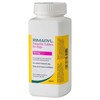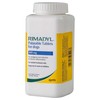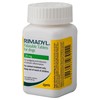Rimadyl
Rimadyl Tablets can be used for analgesia and the reduction of chronic inflammation, for example in degenerative joint disease of the dog. They can also be used in the management of post-operative pain in dogs.
Rimadyl Tablets are presented as square light-brown tablets that have been scored down the middle for easy and accurate dosing.
Rimadyl 50mg Palatable Tablets
£0.48Rimadyl 50mg Tablets are indicated for use as part of a chronic pain management strategy for dogs with osteoarthritis. Rimadyl can also be used as a post-operative medication to treat pain...[More info]
Rimadyl 100mg Palatable Tablets
£0.71Rimadyl 100mg Tablets are indicated for use as part of a chronic pain management strategy for dogs with osteoarthritis. Rimadyl can also be used as a post-operative medication to treat pain...[More info]
Rimadyl 20mg Palatable Tablets
£0.28Rimadyl 20mg Tablets are indicated for use as part of a chronic pain management strategy for dogs with osteoarthritis. Rimadyl can also be used as a post-operative medication to treat pain...[More info]
Contra-indications, warnings, etc
The elimination time of NSAIDs, including carprofen, in the cat is longer than in the dog and the therapeutic index is narrower. In the absence of specific data the use of Rimadyl Palatable Tablets in the cat is contra-indicated.
Do not exceed the stated dose.
Do not administer other NSAIDs concurrently or within 24 hours of each other. Some NSAIDs may be highly bound to plasma proteins and compete with other highly bound drugs, which can lead to toxic effects.
Do not use in dogs suffering from cardiac, hepatic or renal disease, where there is a possibility of gastro-intestinal ulceration or bleeding, or where there is evidence of a blood dyscrasia or hypersensitivity to the product. As with other NSAIDs there is a risk of rare renal or idiosyncratic hepatic adverse events.
Use in dogs less than 6 weeks of age, or in aged dogs, may involve additional risk. If such use cannot be avoided, such dogs may require a reduced dosage and careful clinical management.
Avoid use in any dehydrated, hypovolaemic or hypotensive dog, as there is a potential risk of increased renal toxicity.
Concurrent administration of potential nephrotoxic drugs should be avoided.
In the absence of any specific studies in pregnant bitches, such use is not indicated.
NSAIDs can cause inhibition of phagocytosis and hence in the treatment of inflammatory conditions associated with bacterial infection, appropriate concurrent antimicrobial therapy should be instigated.
Due to the palatable nature of the tablets, store in a secure location. Severe adverse reaction may occur if large quantities are ingested. If you suspect your dog has consumed Rimadyl Palatable Tablets above the labelled dose, please contact your veterinarian.
There is no specific antidote for carprofen overdosage but general supportive therapy, as applied to clinical overdosage with NSAIDs should be applied.
In the event of accidental ingestion of the tablets, seek medical advice and show the doctor what has been taken.
Wash hands after handling the product.
Pharmaceutical precautions
Do not store above 25°C. Store in a dry place. Protect from light.
Any unused product or waste materials should be disposed of in accordance with national requirements.
Keep out of the sight and reach of children.
For animal treatment only.
Further information
Experimental and clinical evidence suggests that for carprofen in the dog gastro-intestinal tract ulceration is rare, and only occurs at dosages well above the therapeutic dose.
Following repeated therapeutic dosing for 8 weeks, carprofen has been shown to have no detrimental effect on chronically arthritic canine cartilage in a model of canine osteoarthritis.
In addition, therapeutic concentrations of carprofen have been demonstrated (in vitro) to increase proteoglycan synthesis in chondrocytes from canine arthritic cartilage.
Stimulation of proteoglycan synthesis will narrow the difference between the rate of degeneration and regeneration of cartilage matrix resulting in a slowing of the progression of cartilage loss.


